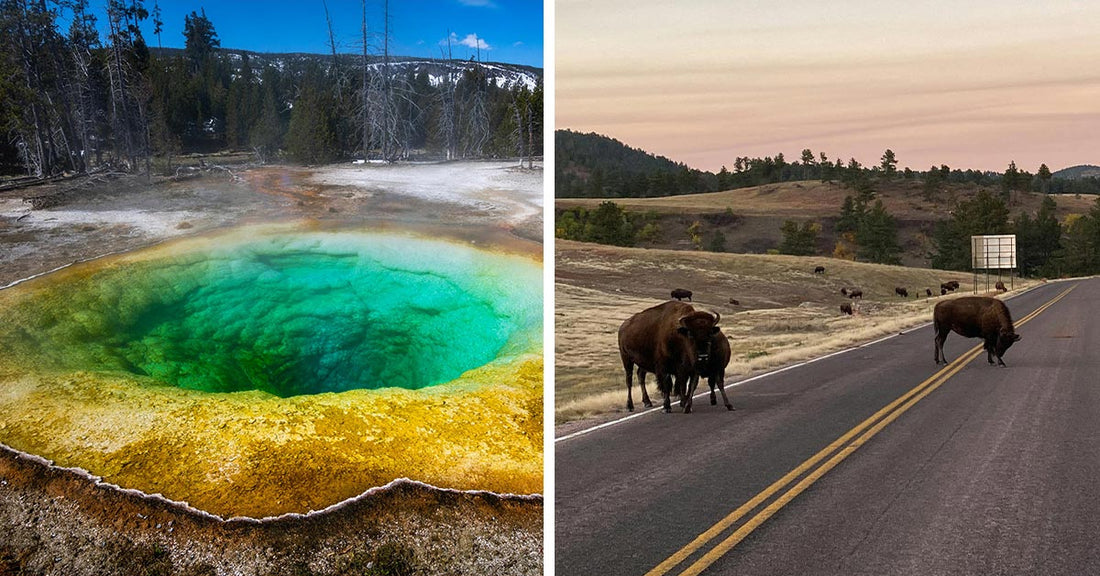Tourists Watch in Horror as Bison Boils Alive at Yellowstone Park's Grand Prismatic Spring
Matthew Russell
A bison stumbled into one of Yellowstone National Park’s most iconic features last week—and never came back out.
The massive animal died after falling into the Grand Prismatic Spring, a natural hot spring known for its vivid colors and scalding temperatures. Tourists at the Midway Geyser Basin, one of the most visited spots in the park, watched in horror as the bison fought to escape the nearly boiling waters before succumbing within moments, according to CBS News.
“There were two bison standing there,” said Louise Howard, who was visiting Yellowstone for the first time from Colorado. “I thought it was a great photo opportunity,” she told CBS.
What unfolded next was anything but picturesque.

A bison died after falling into Yellowstone’s Grand Prismatic Spring.
The Fall Into Grand Prismatic Spring
Howard said one bison stepped into a shallow area and hopped out, but then stumbled as it moved toward the spring’s edge. It lost its footing and plunged into the steaming pool.
“As hard as it tried, it couldn’t get out,” she told the New York Post.
She captured the creature’s final moments on camera.
Michael Poland, a geophysicist and the scientist-in-charge at the Yellowstone Volcano Observatory, said video footage suggests the bison initially approached a ledge that gave way under its weight. He emphasized that this was not an uncommon risk for wildlife in the park.
“Animals walk along these edges all the time,” Poland told NBC News. “Sometimes the crust is thin and collapses.”
The bison’s thrashing pushed it into hotter sections of the spring, accelerating the fatal outcome.

The spring’s temperature reaches 192 degrees Fahrenheit.
Why the Spring Is So Dangerous
Grand Prismatic Spring spans over 300 feet and reaches temperatures as high as 192 degrees Fahrenheit. Because of Yellowstone’s elevation, the boiling point is around 200 degrees.
Despite rumors that the spring’s waters are acidic, Poland clarified that they are not.
“Most of them are actually neutral,” he told Fox News. “But the heat alone is enough. Anyone who’s poached a chicken knows what boiling water does to tissue.”
The carcass, Poland noted, would likely be reduced to bone.
“The boiling water will eat away at the organic material…eventually there will just be some bone,” he told NBC.

The incident happened during Yellowstone’s peak summer season.
Tourists Left Shaken
Witnesses expressed shock and sadness. Katie Hirtzel, who visited later that day, described the scene as “really eerie and mysterious” after discovering the remains through a foggy mist.
“It was huge,” she told CBS, adding that it was “profound” to witness the aftermath of such a raw natural event.
She emphasized the need to respect nature’s power.
“This is nature. This isn’t something that’s scary. This is something that is natural and incredible,” Hirtzel said.
Howard, who had taken the initial photos, echoed that sentiment.
“You never get such a front row seat to nature,” she told CBS. “Those animals are wild and they are doing their thing. We are guests in their area.”

Witnesses described the moment as disturbing and unforgettable.
A Stark Reminder for Visitors
While the bison’s death was swift, the memory lingers as a chilling warning. Yellowstone sees millions of visitors each year, many of whom are drawn to its geothermal features and abundant wildlife. But with beauty comes danger.
Park officials urge visitors to remain on boardwalks and designated trails. The crust surrounding many hot springs is fragile and unpredictable.
“That’s why it’s so important to stay on the boardwalks,” Poland stressed to NBC.
The incident followed two recent bison-related injuries at the park, where tourists got too close to the animals and were gored. Those individuals survived with minor wounds, but the message is clear: Yellowstone is not a petting zoo.
The death of the bison at Grand Prismatic Spring was not just a tragic loss of life. It was a sobering illustration of how fragile the balance is between wild creatures and the natural dangers that surround them—and a powerful reminder that even a national park, so often viewed as a family-friendly destination, can become a place of lethal missteps.

